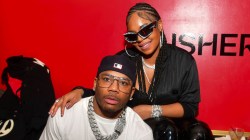Rap’s complicated relationship with religion has raised many a debate from detractors who don’t understand how artists that seem to glorify misogyny and material wealth can still act so pious. It’s a contentious topic that has never held a firm answer, but Ebony A. Utley, a professor at California State University, Long Beach, decided to use her experience growing up entrenched in both religion and Rap music to try and make sense of their complicated co-existence.
Rather than simply praising or condemning rappers’ invocations to God or assertions linking artists to the devil or God, Rap and Religion works to frame these moments in a way that helps the reader better understand how such a dichotomy is possible. While most of the following points may not be solid facts, they stress some of Utley’s conclusions about certain intersections between Rap music and religion in Hip Hop culture.
Here are 10 things HipHopDX learned while reading:

AD LOADING...
- For those wondering why rappers tend to identify so heavily with Jesus, one might want to revisit Jesus’ story. As Utley mentions, the two have much more in common than you’d initially think. Starting with the claim that “the Jesus story is the gangsta story,” she points out that Jesus himself lived a parallel life to that of many rappers: “Jesus fraternized with sexually licentious women, cavorted with sinners, worked on the Sabbath, had a temper, used profance language with religious people, praised faithfulness over stilted forms of religious piety, and honored God more than the government” (49).
- In her chapter “Doin’ it For Daddy,” which outlines several instances of female rappers invoking God as a father-like figure or a lover– and thus reinforcing a gendered hierarchy – Utley furthers her point by asserting that every platinum female rapper has only achieved success through the direct influence of a male artist (32). Therefore, while successful female rappers may look to be making strides for women in Hip Hop, they’re only furthering the agenda of a male-controlled system. Lauryn Hill and Nicki Minaj are two such examples included by Utley, who claims these women were led to fame by Wyclef Jean and Lil Wayne, respectively.
- Utley sees a religious significance in female rappers covering sexually explicit topics because it shows them surpassing the shame previously tied to women and sex. There was normally a religious shame to go along with affirming sexual identity, meaning that rejecting such a notion symbolized surmounting the obstacle of religious shame previously attached to explicitly speaking on sex (41).
- Utley’s third chapter, “The Jesus Piece,” speaks at length about the convoluted message rappers send by wearing Jesus piece pieces. On one hand, she explains that the piece can be interpreted as a sign of spiritual wealth – “Whether made of wood, metal plates, gold, platinum, diamonds, or other gemstones, the Jesus piece must always appear excessively lavish because the Jesus piece represents God’s favor” (65). However, the piece’s design, based off of Caucasian features, also helps perpetuate ideas of white power: “The Whiteness of the Jesus piece epitomizes the power of Whiteness to oppress people of color around the globe. The Jesus piece’s celebration of capitalism succumbs to a racial hierarchy where whiteness represents power” (66).
- Images of Jesus, especially a Black Jesus, in videos and on album covers, is a choice meant to encourage empathy, not cause controversy. As Utley explains when referring to Clipse’s cover for Lord Willin’, which features a Black Jesus riding in the back seat,“Clipse’s Jesus understands that their potential involvement in unscrupulous activities results from a perceived lack of opportunity for young Black males in Virginia or anywhere for that matter. His presence is not so much of a contradiction as it an acknowledgment of their desire for protection, sympathy, and hope in the midst of an untenable situation” (51).
- A devil figure did not exist in African cultures before the advent of colonialism, meaning that lines between good and evil were much more hazy. Instead of a devil, there was a much more complex trickster figure who embodied both good and evil attributes, known as “Exu in Brazil, Echu-Elegua in Cuba, Papa Legba in Haiti, Esu-Elegbara in Nigeria, and Legba in Benin” (69)
- The ongoing claims that stars like Kanye West, Beyonce and Jay-Z are members of the Illuminati who sold their souls to the devil for fame and power propose an interesting commentary on how some choose to explain the success of artists of color. Utley says “it could certainly be said that many of these upwardly mobile Rap stars pose a direct threat to the color of wealth in our society. Claiming their money was an ill-gotten gain is another form of restoring order” (89). Rather than seeing this as simply an attack on their character, Utley chooses to also see ties to evil behavior as an attack on color as well.
- Utley makes a similar argument when pointing out the seeming racial double-standard in place for rappers that produce content with satanic themes. While Eminem hasn’t been labeled satanic in any write-ups about his music, black rappers tend be chastised when they create similar content: “Hip Hop’s model of White boy angst is simply frustrated whereas African Americans are demonic. . . . [Eminem’s] tortured conversations with the devil are mere art whereas Black men are real devils” (90)
- In her chapter “Godly Power,” Utley explains that Lil B, by labeling himself the Based God and saying he looks like Jesus, sets himself up as a deity so that his voice can specifically fall outside of the cultural norms of Hip Hop. She explains that with these labels, “he redefines Hip Hop’s expectations for masculinity and creates space for conversations about homosexuality that other rappers shut down in God’s name” (108). This is countered by her example of Busta Rhymes, who refused to speak on homophobia for the documentary Beyond Beats and Rhymes since, as he relayed, “what I represent culturally doesn’t condone that whatsoever” (108). Since being the Based God elevates Lil B above Hip Hop culture, he sets himself up to tackle issues like homophobia without being hindered by the same obstacles Busta ran into during that interview.
- Although critics were quick to lambast Kanye West for his Rolling Stone cover, where he appeared as a Jesus-like figure, Utley defends the choice, maintaining that the choice was his way of invoking a close relation with God. It was not an appeal to say that he was God, but rather that he was with with God. (59). Later in the book, she also attempts to clear up confusion over his line “I sold my soul to the devil that’s a crappy deal,” mentioning that Kanye never meant the line literally. As he explained in an interview with Sway Calloway during the video release for Runaway, the line was meant to allude to his doubts at the hands of others (87).
Purchase Rap And Religion: Understanding The Gangsta’s Gods by Ebony A. Utley



